MITS5507 Business Process Modelling Report: Research Analysis
VerifiedAdded on 2022/10/10
|9
|1861
|227
Report
AI Summary
This report provides an in-depth analysis of the research paper "Data flow and human tasks in business process models" by Giorgio Bruno. It examines the shift from traditional business process models to artifact-centric approaches, emphasizing the importance of data flow in activating tasks. The report delves into the interactions between processes and tasks, particularly focusing on human tasks and the choices performers can make. It explores two types of human choices: input selection and course of action. Furthermore, the report categorizes human tasks into performer-driven, process-driven, and macro tasks, discussing the characteristics and patterns within each category. The methodology employed is secondary data analysis, combining qualitative and quantitative approaches to ensure data accuracy. Observations are made on performer and process-driven tasks, highlighting the generative, associative, and acquisitive patterns. The report identifies the coexistence of control flow and data flow as a key problem and concludes by summarizing the key findings and relevancy to business process modelling.
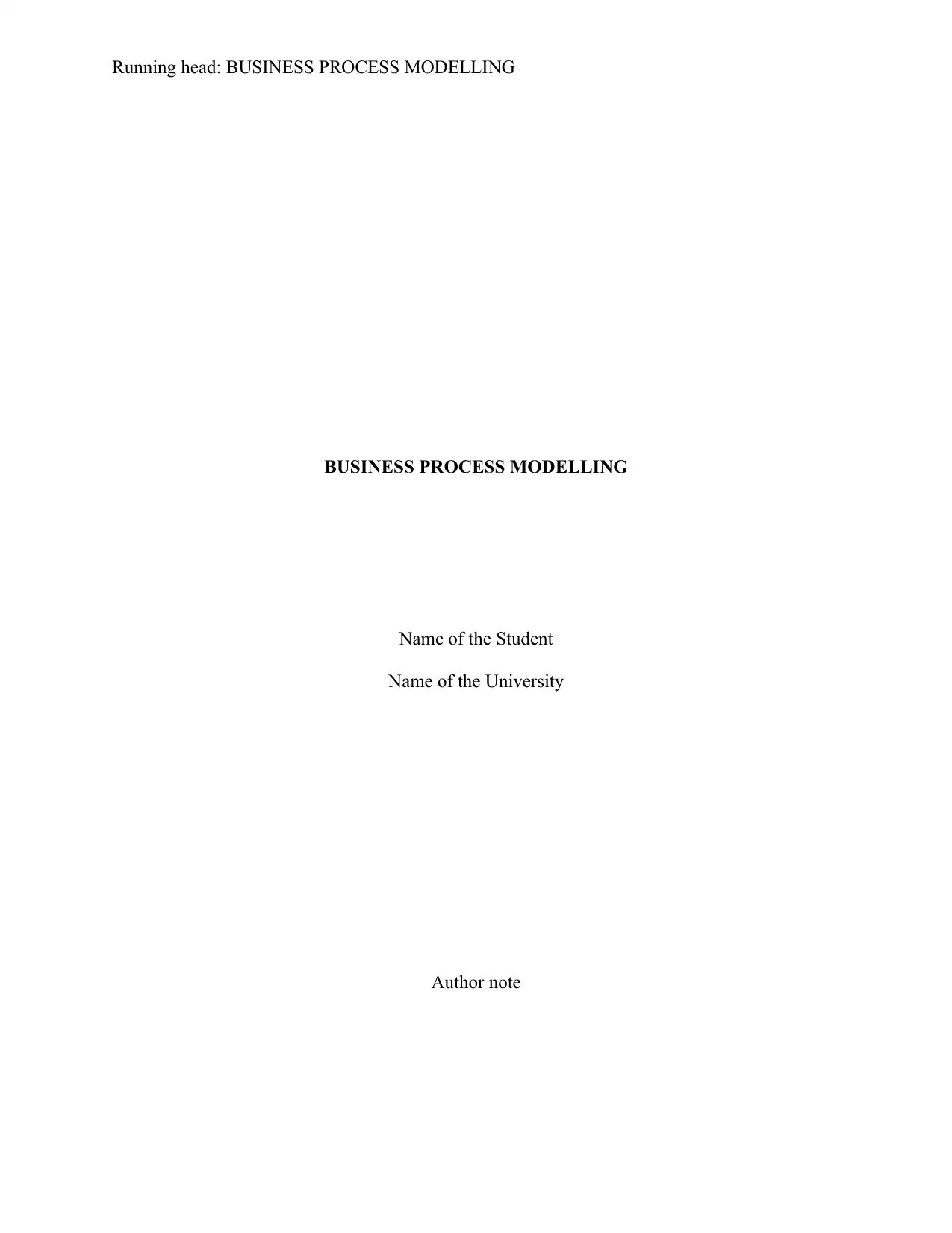
Running head: BUSINESS PROCESS MODELLING
BUSINESS PROCESS MODELLING
Name of the Student
Name of the University
Author note
BUSINESS PROCESS MODELLING
Name of the Student
Name of the University
Author note
Secure Best Marks with AI Grader
Need help grading? Try our AI Grader for instant feedback on your assignments.
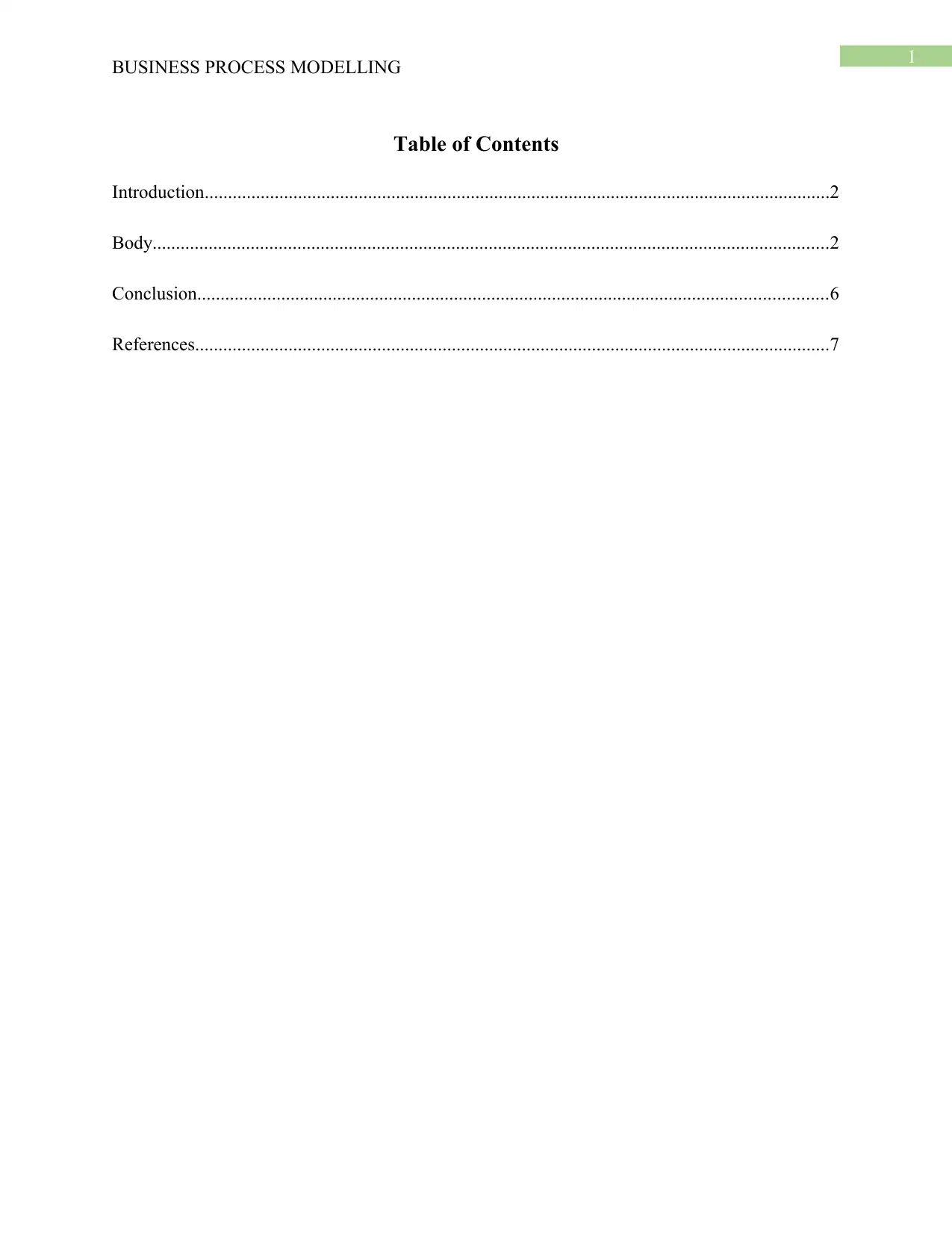
1
BUSINESS PROCESS MODELLING
Table of Contents
Introduction......................................................................................................................................2
Body.................................................................................................................................................2
Conclusion.......................................................................................................................................6
References........................................................................................................................................7
BUSINESS PROCESS MODELLING
Table of Contents
Introduction......................................................................................................................................2
Body.................................................................................................................................................2
Conclusion.......................................................................................................................................6
References........................................................................................................................................7
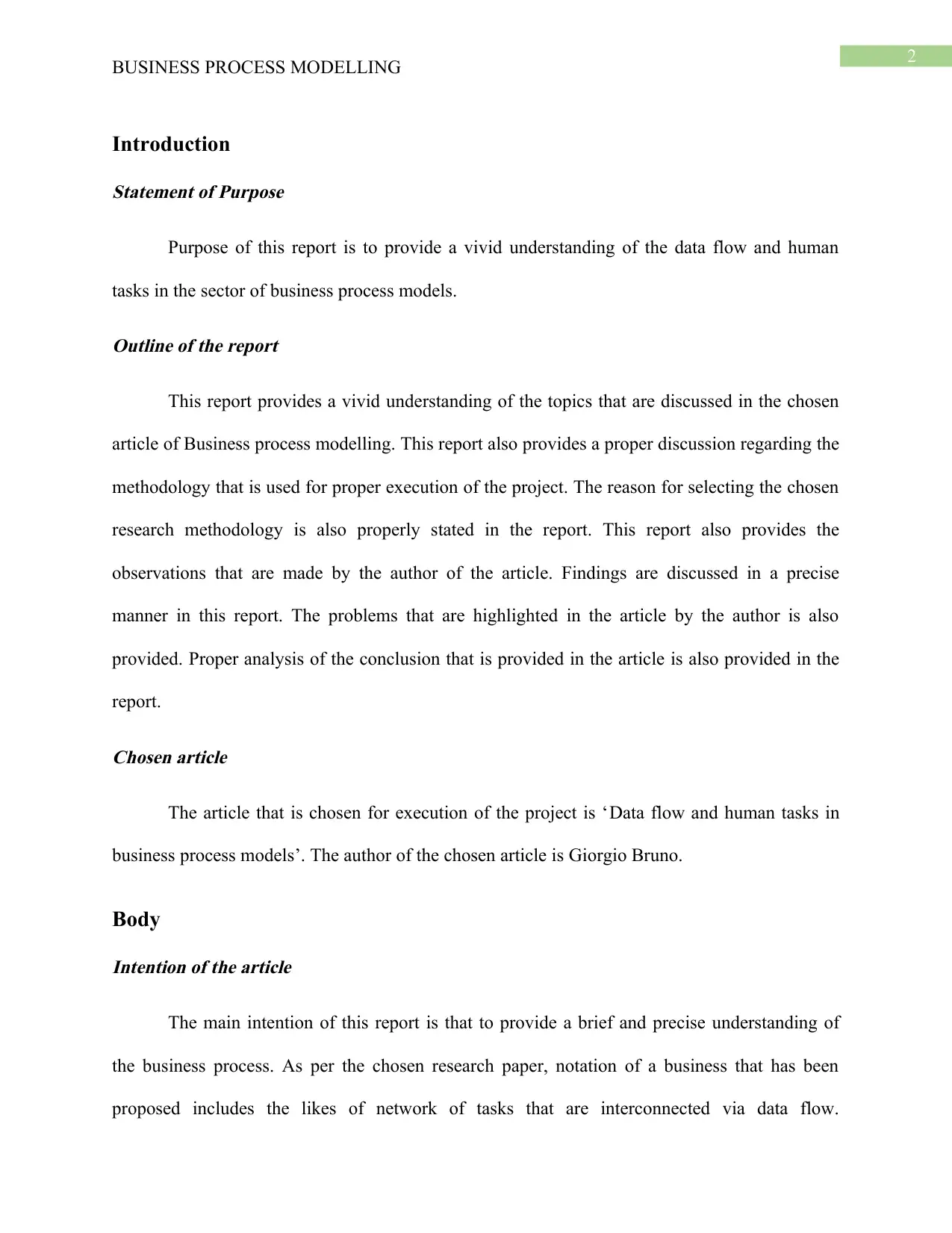
2
BUSINESS PROCESS MODELLING
Introduction
Statement of Purpose
Purpose of this report is to provide a vivid understanding of the data flow and human
tasks in the sector of business process models.
Outline of the report
This report provides a vivid understanding of the topics that are discussed in the chosen
article of Business process modelling. This report also provides a proper discussion regarding the
methodology that is used for proper execution of the project. The reason for selecting the chosen
research methodology is also properly stated in the report. This report also provides the
observations that are made by the author of the article. Findings are discussed in a precise
manner in this report. The problems that are highlighted in the article by the author is also
provided. Proper analysis of the conclusion that is provided in the article is also provided in the
report.
Chosen article
The article that is chosen for execution of the project is ‘Data flow and human tasks in
business process models’. The author of the chosen article is Giorgio Bruno.
Body
Intention of the article
The main intention of this report is that to provide a brief and precise understanding of
the business process. As per the chosen research paper, notation of a business that has been
proposed includes the likes of network of tasks that are interconnected via data flow.
BUSINESS PROCESS MODELLING
Introduction
Statement of Purpose
Purpose of this report is to provide a vivid understanding of the data flow and human
tasks in the sector of business process models.
Outline of the report
This report provides a vivid understanding of the topics that are discussed in the chosen
article of Business process modelling. This report also provides a proper discussion regarding the
methodology that is used for proper execution of the project. The reason for selecting the chosen
research methodology is also properly stated in the report. This report also provides the
observations that are made by the author of the article. Findings are discussed in a precise
manner in this report. The problems that are highlighted in the article by the author is also
provided. Proper analysis of the conclusion that is provided in the article is also provided in the
report.
Chosen article
The article that is chosen for execution of the project is ‘Data flow and human tasks in
business process models’. The author of the chosen article is Giorgio Bruno.
Body
Intention of the article
The main intention of this report is that to provide a brief and precise understanding of
the business process. As per the chosen research paper, notation of a business that has been
proposed includes the likes of network of tasks that are interconnected via data flow.
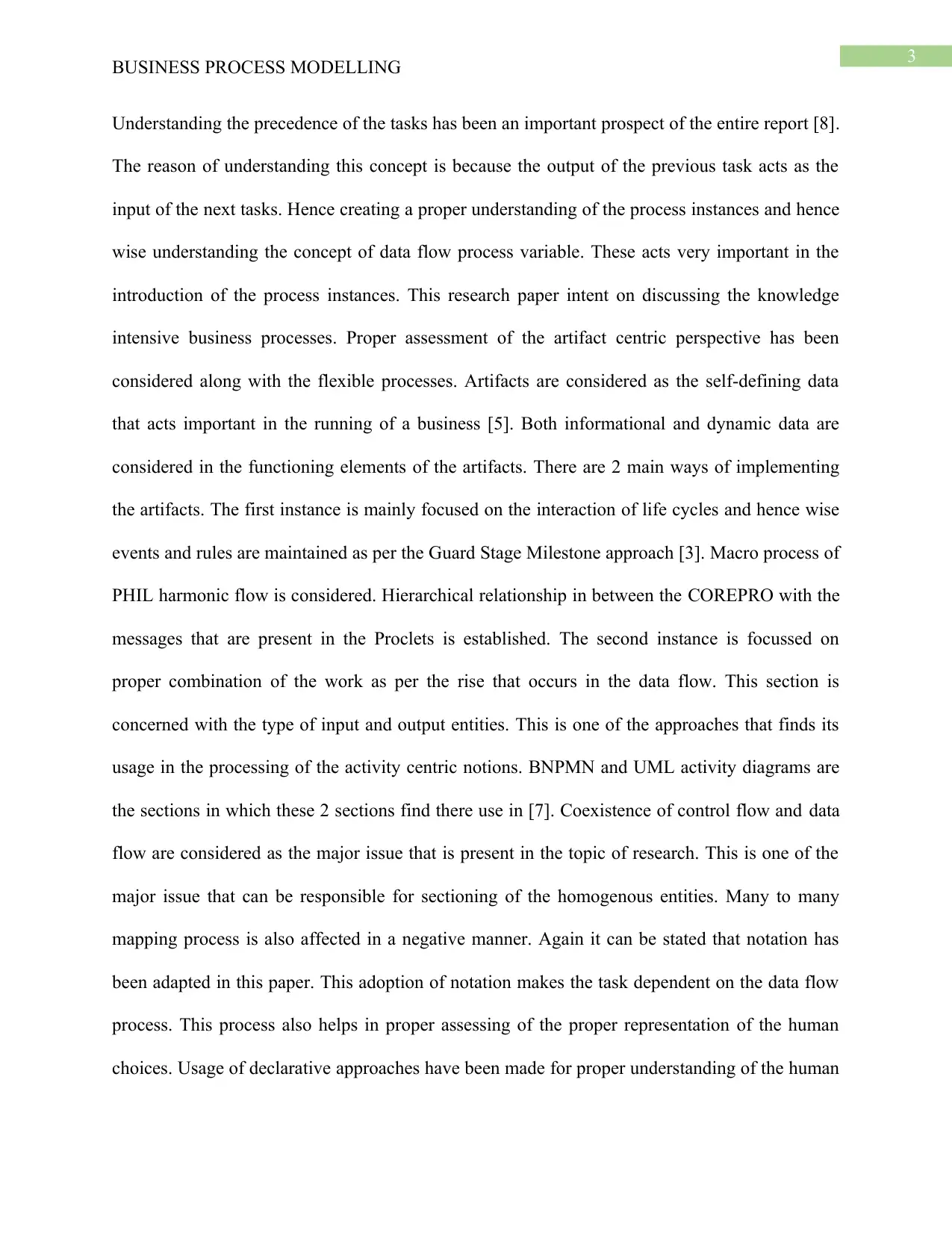
3
BUSINESS PROCESS MODELLING
Understanding the precedence of the tasks has been an important prospect of the entire report [8].
The reason of understanding this concept is because the output of the previous task acts as the
input of the next tasks. Hence creating a proper understanding of the process instances and hence
wise understanding the concept of data flow process variable. These acts very important in the
introduction of the process instances. This research paper intent on discussing the knowledge
intensive business processes. Proper assessment of the artifact centric perspective has been
considered along with the flexible processes. Artifacts are considered as the self-defining data
that acts important in the running of a business [5]. Both informational and dynamic data are
considered in the functioning elements of the artifacts. There are 2 main ways of implementing
the artifacts. The first instance is mainly focused on the interaction of life cycles and hence wise
events and rules are maintained as per the Guard Stage Milestone approach [3]. Macro process of
PHIL harmonic flow is considered. Hierarchical relationship in between the COREPRO with the
messages that are present in the Proclets is established. The second instance is focussed on
proper combination of the work as per the rise that occurs in the data flow. This section is
concerned with the type of input and output entities. This is one of the approaches that finds its
usage in the processing of the activity centric notions. BNPMN and UML activity diagrams are
the sections in which these 2 sections find there use in [7]. Coexistence of control flow and data
flow are considered as the major issue that is present in the topic of research. This is one of the
major issue that can be responsible for sectioning of the homogenous entities. Many to many
mapping process is also affected in a negative manner. Again it can be stated that notation has
been adapted in this paper. This adoption of notation makes the task dependent on the data flow
process. This process also helps in proper assessing of the proper representation of the human
choices. Usage of declarative approaches have been made for proper understanding of the human
BUSINESS PROCESS MODELLING
Understanding the precedence of the tasks has been an important prospect of the entire report [8].
The reason of understanding this concept is because the output of the previous task acts as the
input of the next tasks. Hence creating a proper understanding of the process instances and hence
wise understanding the concept of data flow process variable. These acts very important in the
introduction of the process instances. This research paper intent on discussing the knowledge
intensive business processes. Proper assessment of the artifact centric perspective has been
considered along with the flexible processes. Artifacts are considered as the self-defining data
that acts important in the running of a business [5]. Both informational and dynamic data are
considered in the functioning elements of the artifacts. There are 2 main ways of implementing
the artifacts. The first instance is mainly focused on the interaction of life cycles and hence wise
events and rules are maintained as per the Guard Stage Milestone approach [3]. Macro process of
PHIL harmonic flow is considered. Hierarchical relationship in between the COREPRO with the
messages that are present in the Proclets is established. The second instance is focussed on
proper combination of the work as per the rise that occurs in the data flow. This section is
concerned with the type of input and output entities. This is one of the approaches that finds its
usage in the processing of the activity centric notions. BNPMN and UML activity diagrams are
the sections in which these 2 sections find there use in [7]. Coexistence of control flow and data
flow are considered as the major issue that is present in the topic of research. This is one of the
major issue that can be responsible for sectioning of the homogenous entities. Many to many
mapping process is also affected in a negative manner. Again it can be stated that notation has
been adapted in this paper. This adoption of notation makes the task dependent on the data flow
process. This process also helps in proper assessing of the proper representation of the human
choices. Usage of declarative approaches have been made for proper understanding of the human
Secure Best Marks with AI Grader
Need help grading? Try our AI Grader for instant feedback on your assignments.
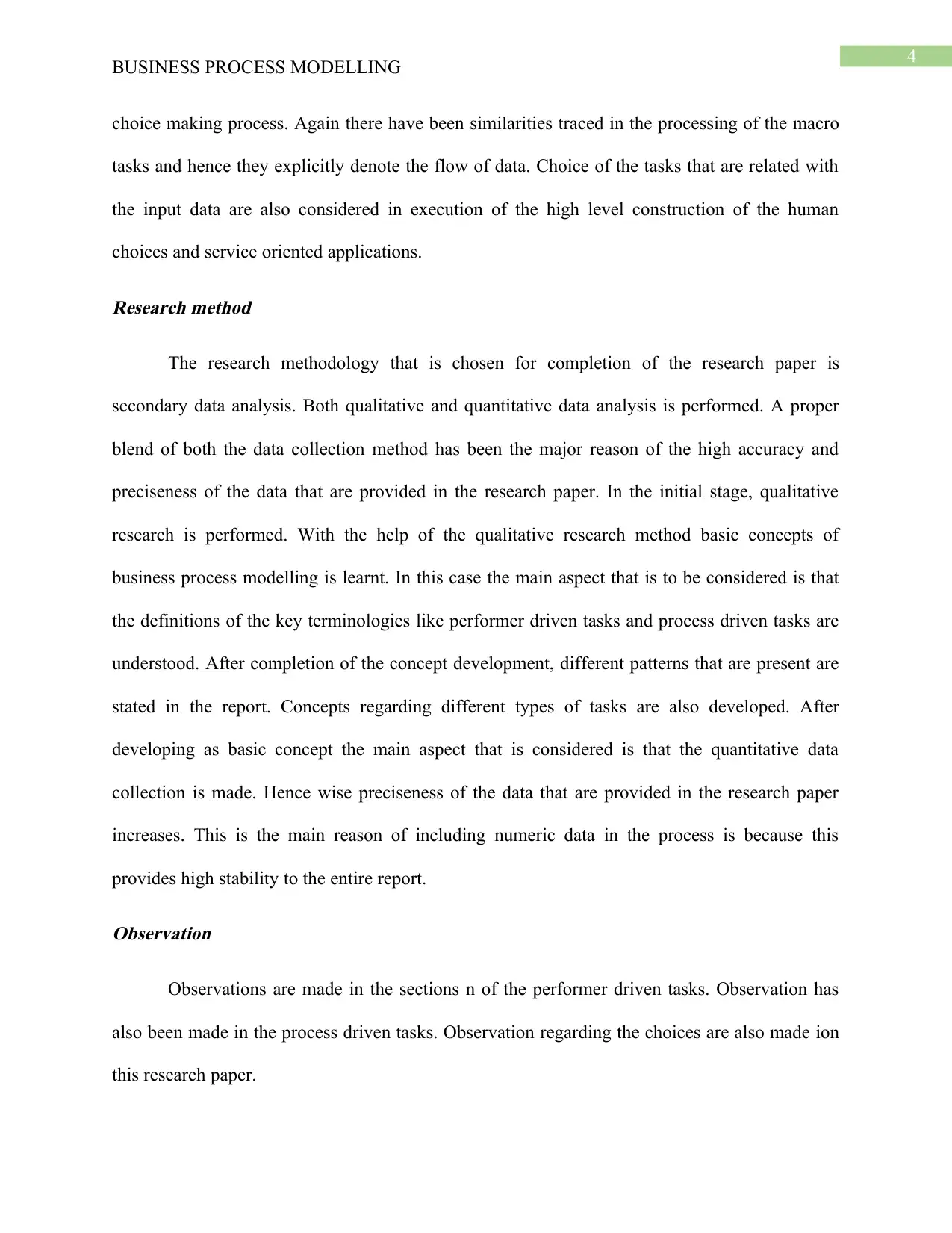
4
BUSINESS PROCESS MODELLING
choice making process. Again there have been similarities traced in the processing of the macro
tasks and hence they explicitly denote the flow of data. Choice of the tasks that are related with
the input data are also considered in execution of the high level construction of the human
choices and service oriented applications.
Research method
The research methodology that is chosen for completion of the research paper is
secondary data analysis. Both qualitative and quantitative data analysis is performed. A proper
blend of both the data collection method has been the major reason of the high accuracy and
preciseness of the data that are provided in the research paper. In the initial stage, qualitative
research is performed. With the help of the qualitative research method basic concepts of
business process modelling is learnt. In this case the main aspect that is to be considered is that
the definitions of the key terminologies like performer driven tasks and process driven tasks are
understood. After completion of the concept development, different patterns that are present are
stated in the report. Concepts regarding different types of tasks are also developed. After
developing as basic concept the main aspect that is considered is that the quantitative data
collection is made. Hence wise preciseness of the data that are provided in the research paper
increases. This is the main reason of including numeric data in the process is because this
provides high stability to the entire report.
Observation
Observations are made in the sections n of the performer driven tasks. Observation has
also been made in the process driven tasks. Observation regarding the choices are also made ion
this research paper.
BUSINESS PROCESS MODELLING
choice making process. Again there have been similarities traced in the processing of the macro
tasks and hence they explicitly denote the flow of data. Choice of the tasks that are related with
the input data are also considered in execution of the high level construction of the human
choices and service oriented applications.
Research method
The research methodology that is chosen for completion of the research paper is
secondary data analysis. Both qualitative and quantitative data analysis is performed. A proper
blend of both the data collection method has been the major reason of the high accuracy and
preciseness of the data that are provided in the research paper. In the initial stage, qualitative
research is performed. With the help of the qualitative research method basic concepts of
business process modelling is learnt. In this case the main aspect that is to be considered is that
the definitions of the key terminologies like performer driven tasks and process driven tasks are
understood. After completion of the concept development, different patterns that are present are
stated in the report. Concepts regarding different types of tasks are also developed. After
developing as basic concept the main aspect that is considered is that the quantitative data
collection is made. Hence wise preciseness of the data that are provided in the research paper
increases. This is the main reason of including numeric data in the process is because this
provides high stability to the entire report.
Observation
Observations are made in the sections n of the performer driven tasks. Observation has
also been made in the process driven tasks. Observation regarding the choices are also made ion
this research paper.
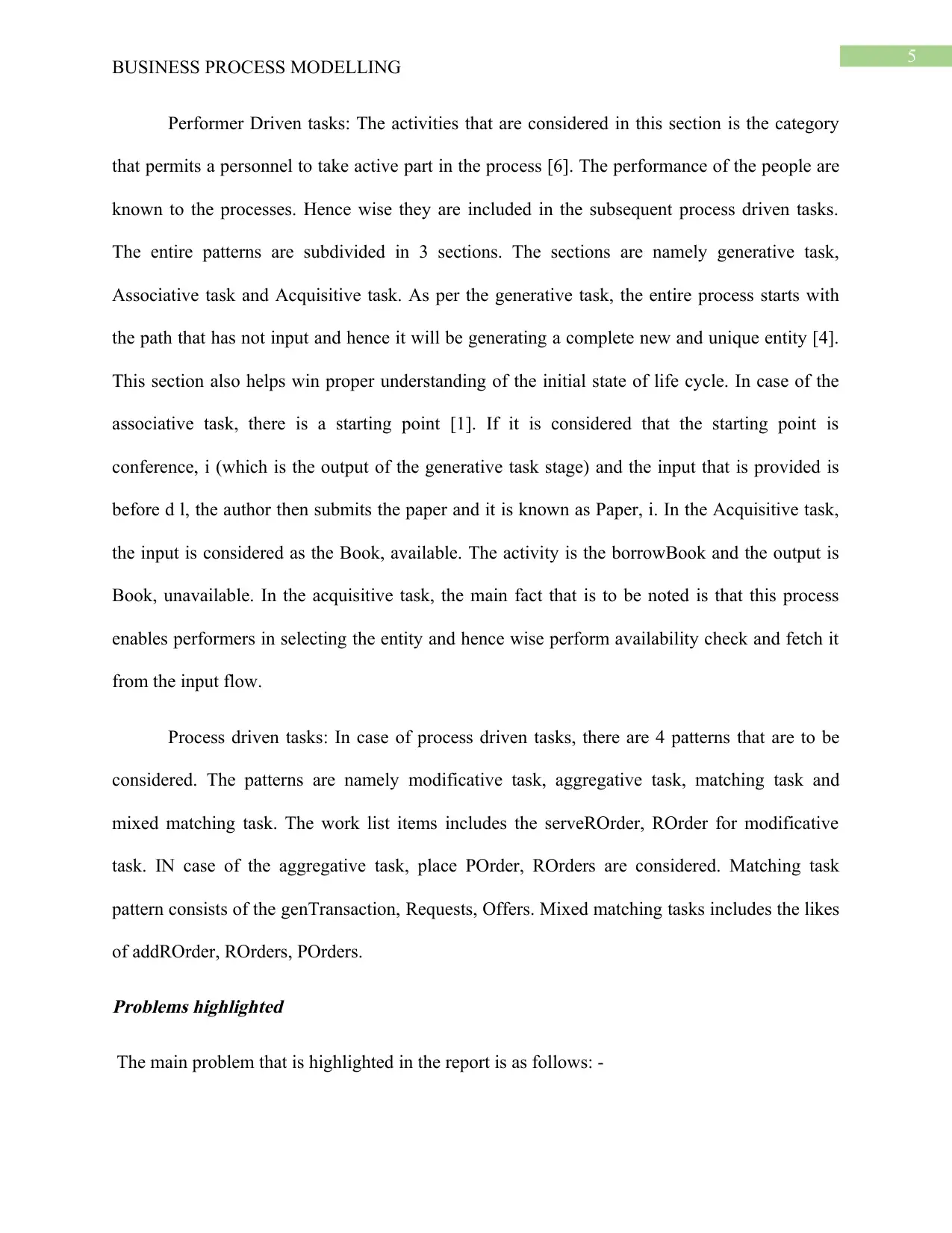
5
BUSINESS PROCESS MODELLING
Performer Driven tasks: The activities that are considered in this section is the category
that permits a personnel to take active part in the process [6]. The performance of the people are
known to the processes. Hence wise they are included in the subsequent process driven tasks.
The entire patterns are subdivided in 3 sections. The sections are namely generative task,
Associative task and Acquisitive task. As per the generative task, the entire process starts with
the path that has not input and hence it will be generating a complete new and unique entity [4].
This section also helps win proper understanding of the initial state of life cycle. In case of the
associative task, there is a starting point [1]. If it is considered that the starting point is
conference, i (which is the output of the generative task stage) and the input that is provided is
before d l, the author then submits the paper and it is known as Paper, i. In the Acquisitive task,
the input is considered as the Book, available. The activity is the borrowBook and the output is
Book, unavailable. In the acquisitive task, the main fact that is to be noted is that this process
enables performers in selecting the entity and hence wise perform availability check and fetch it
from the input flow.
Process driven tasks: In case of process driven tasks, there are 4 patterns that are to be
considered. The patterns are namely modificative task, aggregative task, matching task and
mixed matching task. The work list items includes the serveROrder, ROrder for modificative
task. IN case of the aggregative task, place POrder, ROrders are considered. Matching task
pattern consists of the genTransaction, Requests, Offers. Mixed matching tasks includes the likes
of addROrder, ROrders, POrders.
Problems highlighted
The main problem that is highlighted in the report is as follows: -
BUSINESS PROCESS MODELLING
Performer Driven tasks: The activities that are considered in this section is the category
that permits a personnel to take active part in the process [6]. The performance of the people are
known to the processes. Hence wise they are included in the subsequent process driven tasks.
The entire patterns are subdivided in 3 sections. The sections are namely generative task,
Associative task and Acquisitive task. As per the generative task, the entire process starts with
the path that has not input and hence it will be generating a complete new and unique entity [4].
This section also helps win proper understanding of the initial state of life cycle. In case of the
associative task, there is a starting point [1]. If it is considered that the starting point is
conference, i (which is the output of the generative task stage) and the input that is provided is
before d l, the author then submits the paper and it is known as Paper, i. In the Acquisitive task,
the input is considered as the Book, available. The activity is the borrowBook and the output is
Book, unavailable. In the acquisitive task, the main fact that is to be noted is that this process
enables performers in selecting the entity and hence wise perform availability check and fetch it
from the input flow.
Process driven tasks: In case of process driven tasks, there are 4 patterns that are to be
considered. The patterns are namely modificative task, aggregative task, matching task and
mixed matching task. The work list items includes the serveROrder, ROrder for modificative
task. IN case of the aggregative task, place POrder, ROrders are considered. Matching task
pattern consists of the genTransaction, Requests, Offers. Mixed matching tasks includes the likes
of addROrder, ROrders, POrders.
Problems highlighted
The main problem that is highlighted in the report is as follows: -
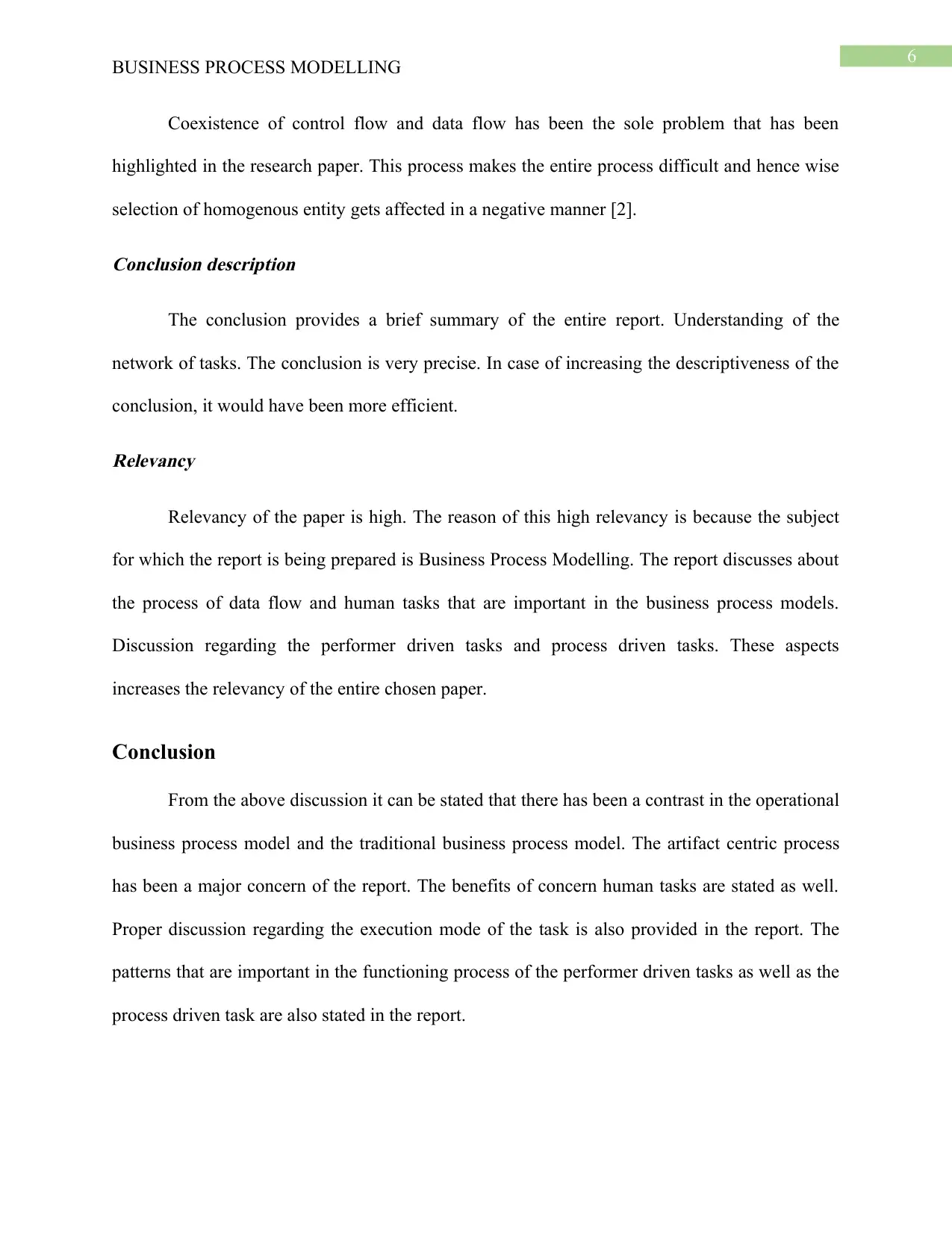
6
BUSINESS PROCESS MODELLING
Coexistence of control flow and data flow has been the sole problem that has been
highlighted in the research paper. This process makes the entire process difficult and hence wise
selection of homogenous entity gets affected in a negative manner [2].
Conclusion description
The conclusion provides a brief summary of the entire report. Understanding of the
network of tasks. The conclusion is very precise. In case of increasing the descriptiveness of the
conclusion, it would have been more efficient.
Relevancy
Relevancy of the paper is high. The reason of this high relevancy is because the subject
for which the report is being prepared is Business Process Modelling. The report discusses about
the process of data flow and human tasks that are important in the business process models.
Discussion regarding the performer driven tasks and process driven tasks. These aspects
increases the relevancy of the entire chosen paper.
Conclusion
From the above discussion it can be stated that there has been a contrast in the operational
business process model and the traditional business process model. The artifact centric process
has been a major concern of the report. The benefits of concern human tasks are stated as well.
Proper discussion regarding the execution mode of the task is also provided in the report. The
patterns that are important in the functioning process of the performer driven tasks as well as the
process driven task are also stated in the report.
BUSINESS PROCESS MODELLING
Coexistence of control flow and data flow has been the sole problem that has been
highlighted in the research paper. This process makes the entire process difficult and hence wise
selection of homogenous entity gets affected in a negative manner [2].
Conclusion description
The conclusion provides a brief summary of the entire report. Understanding of the
network of tasks. The conclusion is very precise. In case of increasing the descriptiveness of the
conclusion, it would have been more efficient.
Relevancy
Relevancy of the paper is high. The reason of this high relevancy is because the subject
for which the report is being prepared is Business Process Modelling. The report discusses about
the process of data flow and human tasks that are important in the business process models.
Discussion regarding the performer driven tasks and process driven tasks. These aspects
increases the relevancy of the entire chosen paper.
Conclusion
From the above discussion it can be stated that there has been a contrast in the operational
business process model and the traditional business process model. The artifact centric process
has been a major concern of the report. The benefits of concern human tasks are stated as well.
Proper discussion regarding the execution mode of the task is also provided in the report. The
patterns that are important in the functioning process of the performer driven tasks as well as the
process driven task are also stated in the report.
Paraphrase This Document
Need a fresh take? Get an instant paraphrase of this document with our AI Paraphraser
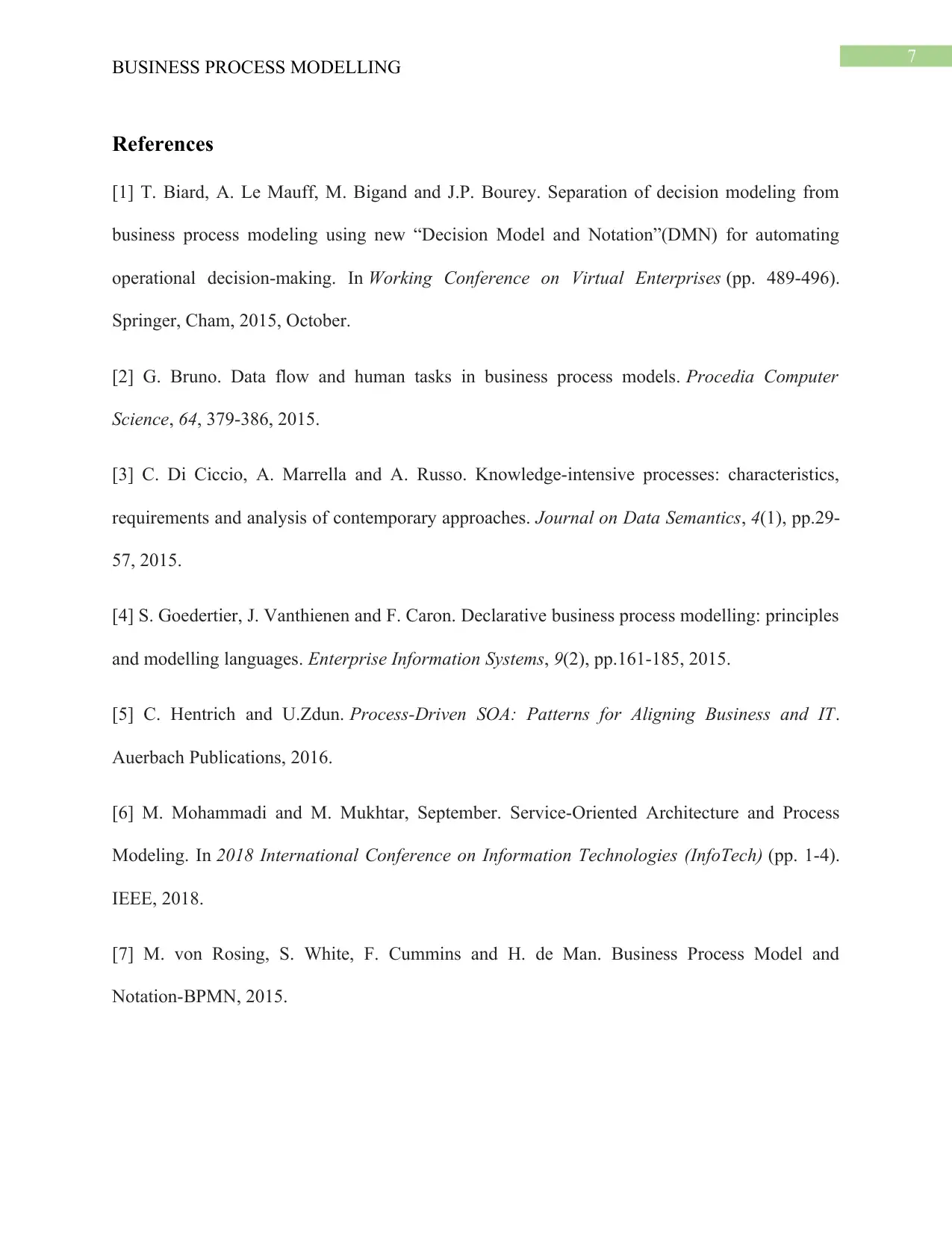
7
BUSINESS PROCESS MODELLING
References
[1] T. Biard, A. Le Mauff, M. Bigand and J.P. Bourey. Separation of decision modeling from
business process modeling using new “Decision Model and Notation”(DMN) for automating
operational decision-making. In Working Conference on Virtual Enterprises (pp. 489-496).
Springer, Cham, 2015, October.
[2] G. Bruno. Data flow and human tasks in business process models. Procedia Computer
Science, 64, 379-386, 2015.
[3] C. Di Ciccio, A. Marrella and A. Russo. Knowledge-intensive processes: characteristics,
requirements and analysis of contemporary approaches. Journal on Data Semantics, 4(1), pp.29-
57, 2015.
[4] S. Goedertier, J. Vanthienen and F. Caron. Declarative business process modelling: principles
and modelling languages. Enterprise Information Systems, 9(2), pp.161-185, 2015.
[5] C. Hentrich and U.Zdun. Process-Driven SOA: Patterns for Aligning Business and IT.
Auerbach Publications, 2016.
[6] M. Mohammadi and M. Mukhtar, September. Service-Oriented Architecture and Process
Modeling. In 2018 International Conference on Information Technologies (InfoTech) (pp. 1-4).
IEEE, 2018.
[7] M. von Rosing, S. White, F. Cummins and H. de Man. Business Process Model and
Notation-BPMN, 2015.
BUSINESS PROCESS MODELLING
References
[1] T. Biard, A. Le Mauff, M. Bigand and J.P. Bourey. Separation of decision modeling from
business process modeling using new “Decision Model and Notation”(DMN) for automating
operational decision-making. In Working Conference on Virtual Enterprises (pp. 489-496).
Springer, Cham, 2015, October.
[2] G. Bruno. Data flow and human tasks in business process models. Procedia Computer
Science, 64, 379-386, 2015.
[3] C. Di Ciccio, A. Marrella and A. Russo. Knowledge-intensive processes: characteristics,
requirements and analysis of contemporary approaches. Journal on Data Semantics, 4(1), pp.29-
57, 2015.
[4] S. Goedertier, J. Vanthienen and F. Caron. Declarative business process modelling: principles
and modelling languages. Enterprise Information Systems, 9(2), pp.161-185, 2015.
[5] C. Hentrich and U.Zdun. Process-Driven SOA: Patterns for Aligning Business and IT.
Auerbach Publications, 2016.
[6] M. Mohammadi and M. Mukhtar, September. Service-Oriented Architecture and Process
Modeling. In 2018 International Conference on Information Technologies (InfoTech) (pp. 1-4).
IEEE, 2018.
[7] M. von Rosing, S. White, F. Cummins and H. de Man. Business Process Model and
Notation-BPMN, 2015.
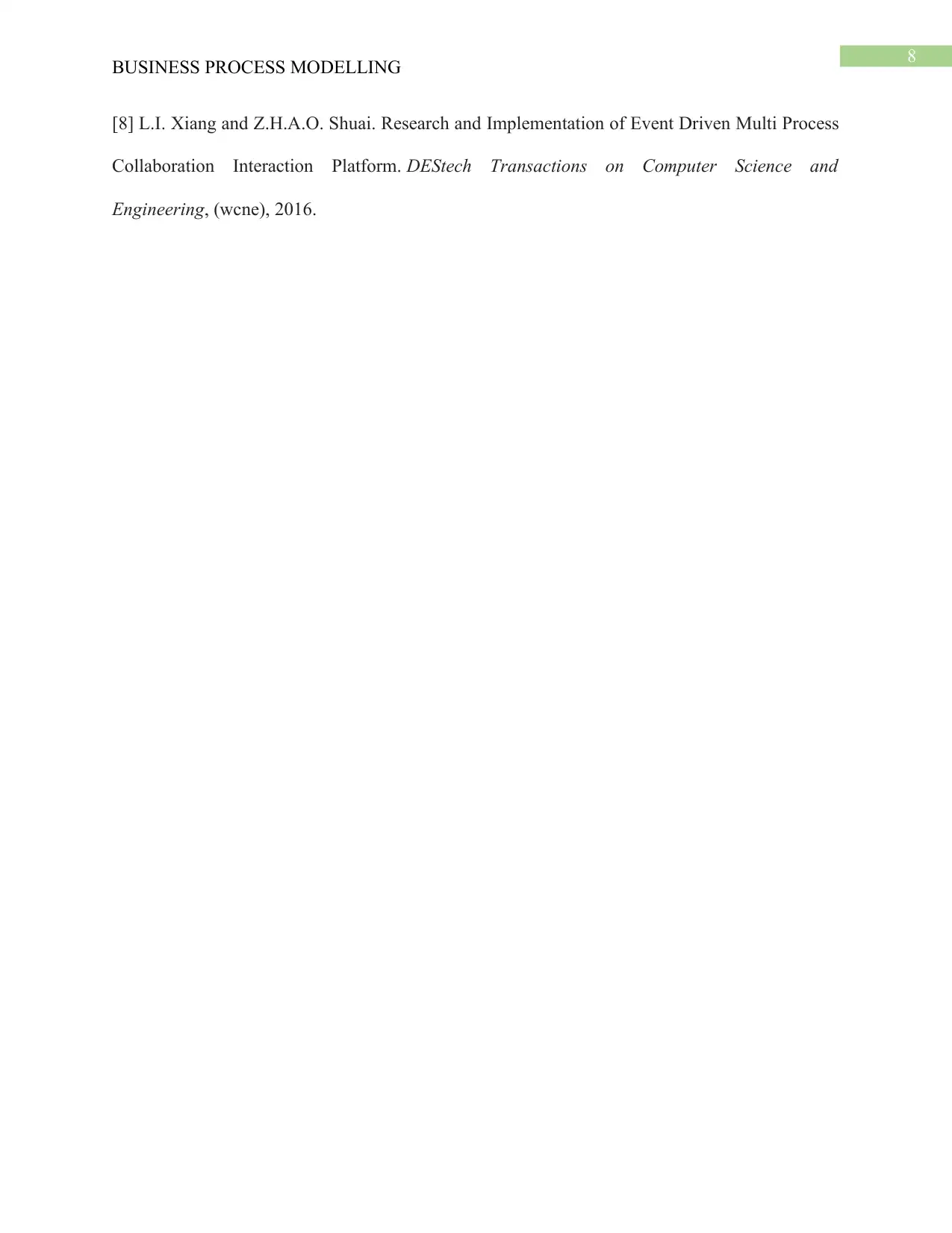
8
BUSINESS PROCESS MODELLING
[8] L.I. Xiang and Z.H.A.O. Shuai. Research and Implementation of Event Driven Multi Process
Collaboration Interaction Platform. DEStech Transactions on Computer Science and
Engineering, (wcne), 2016.
BUSINESS PROCESS MODELLING
[8] L.I. Xiang and Z.H.A.O. Shuai. Research and Implementation of Event Driven Multi Process
Collaboration Interaction Platform. DEStech Transactions on Computer Science and
Engineering, (wcne), 2016.
1 out of 9
Related Documents
Your All-in-One AI-Powered Toolkit for Academic Success.
+13062052269
info@desklib.com
Available 24*7 on WhatsApp / Email
![[object Object]](/_next/static/media/star-bottom.7253800d.svg)
Unlock your academic potential
© 2024 | Zucol Services PVT LTD | All rights reserved.





